1996 CHEVROLET CAVALIER checking oil
[x] Cancel search: checking oilPage 132 of 372
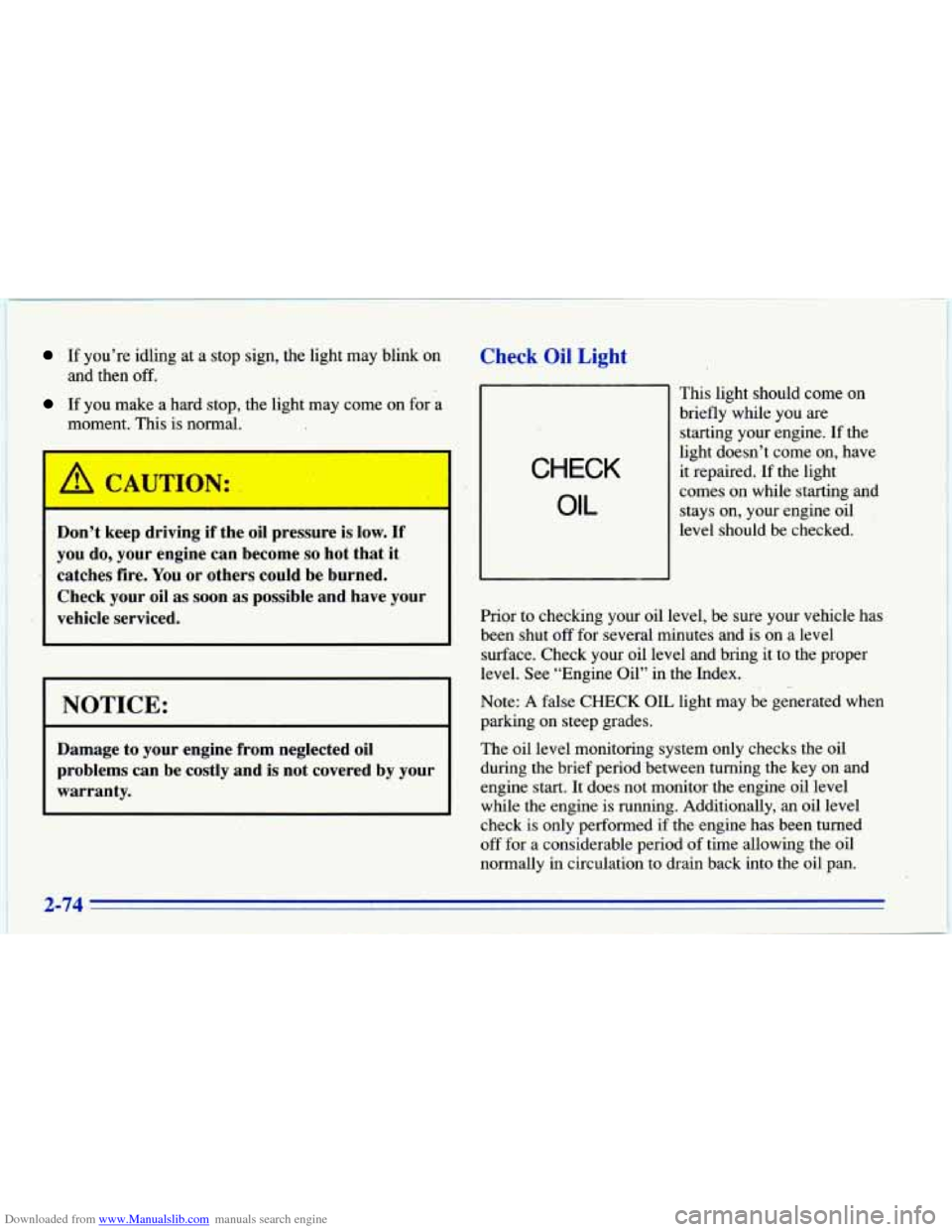
Downloaded from www.Manualslib.com manuals search engine If you’re idling at a stop sign, the light may blink on
If you make a hard stop, the light may come on for a
and then off.
moment. This is normal.
Don’t keep driving if the oil pressure is low. If
you do, your engine can become
so hot that it
catches fire.
You or others could be burned.
Check your
oil as soon as possible and have your
vehicle serviced.
I NOTICE:
Damage to your engine from neglected oil
problems can be costly and
is not covered by your
warranty.
Check Oil Light
CHECK
OIL
Prior to checking your oil le! This light should come
on
briefly while you are
starting your engine. If the
light doesn’t come on, have
it repaired.
‘If the light
comes on while starting and
stays on, your engine oil
level should be checked.
,el, be sure
yo bur vehicle has
been shut
off for several minutes and is on a level
surface. Check your oil level and bring it to the proper
level. See “Engine Oil” in the Index.
Note: A false CHECK
OIL light may. be generated when
parking on steep grades.
The oil level monitoring system only checks the oil
during the brief period between turning the key on and
engine start. It does not monitor the engine oil level
while the engine
is running. Additionally, an oil level
check is only performed
if the engine has been turned
off for a considerable period of time allowing the oil
normally in circulation to drain back into the oil pan.
Page 244 of 372
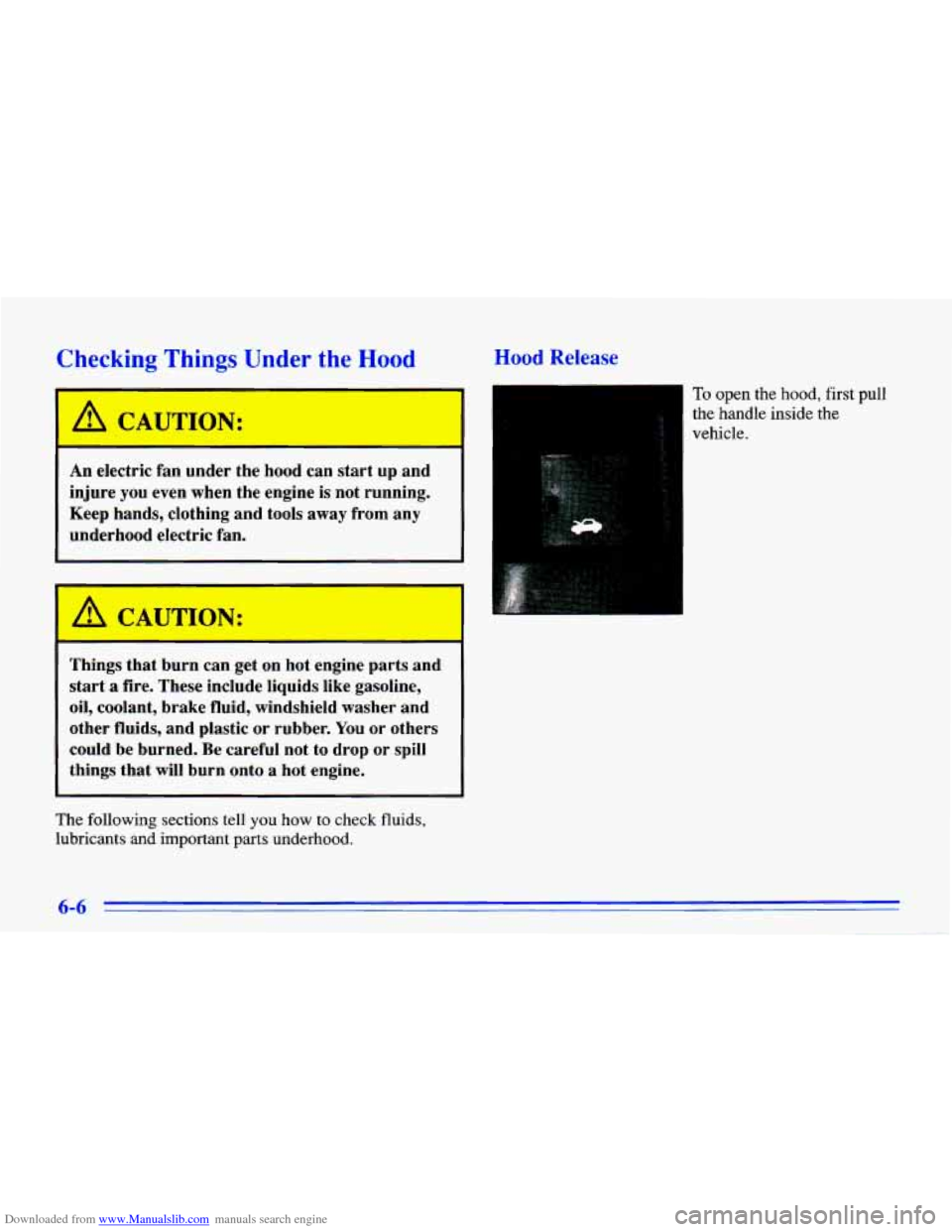
Downloaded from www.Manualslib.com manuals search engine Checking Things Under the Hood Hood Release
1
An electric fan under the hood can start up and
injure
you even when the engine is not running.
Keep hands, clothing and tools away from
any
underhood electric fan.
A CAUTION:
- -
Things that burn can get on hot engine parts and
start
a fire. These include liquids like gasoline,
oil, coolant, brake fluid, windshield washer and
other fluids, and plastic or rubber. You or others
could be burned. Be careful not to drop or spill
things that will burn onto
a hot engine.
The following sections tell
you how to check fluids,
lubricants
and important parts underhood.
1
To open the hood, first pull
the handle inside the
vehicle.
6-6
Page 249 of 372
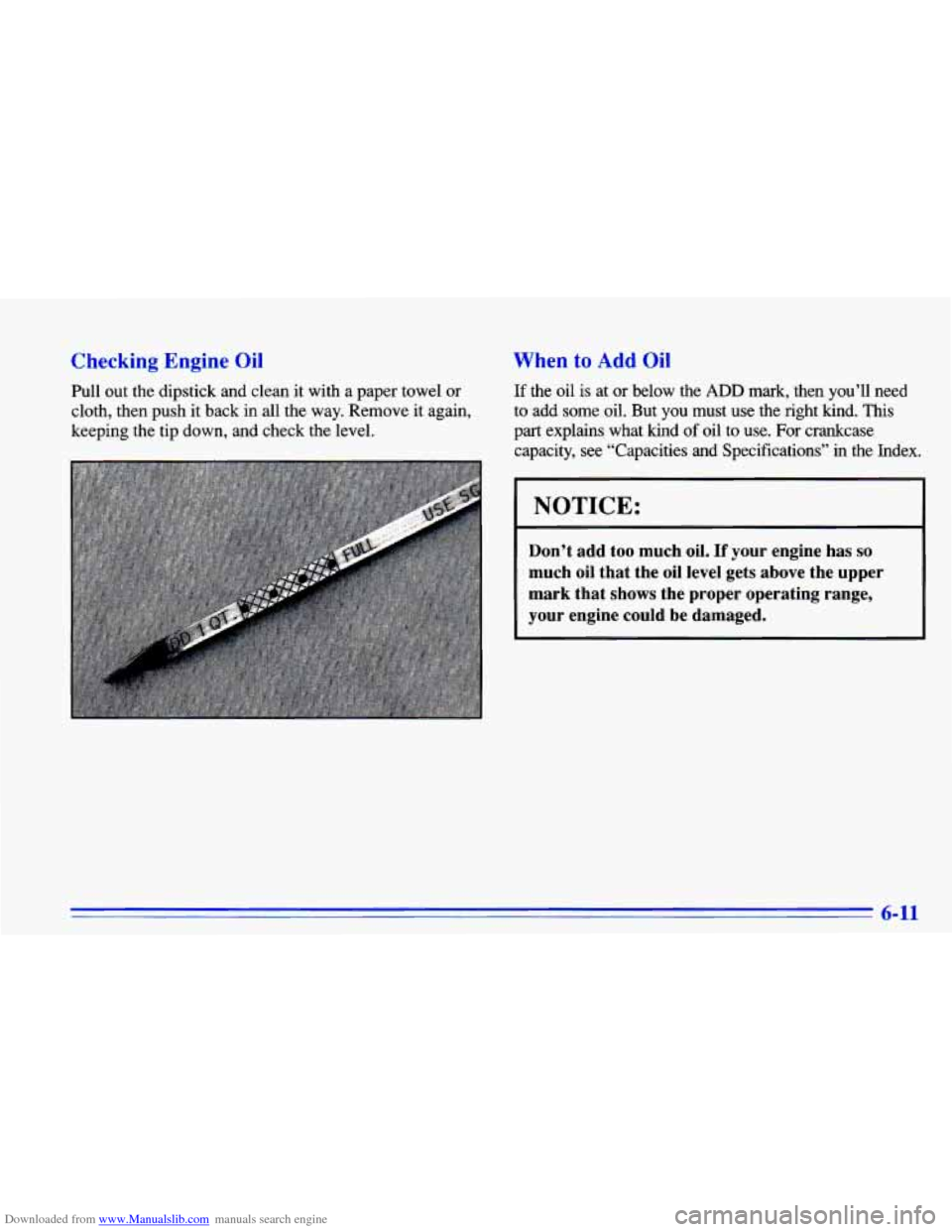
Downloaded from www.Manualslib.com manuals search engine Checking Engine Oil
Pull out the dipstick and clean it with a paper towel or
cloth, then push it back in
all the way. Remove it again,
keeping the tip down, and check the level.
When to Add Oil
If the oil is at or below the ADD mark, then you’ll need
to add some oil. But you must use the right kind.
This
part explains what kind of oil to use. For crankcase
capacity, see “Capacities and Specifications”
in the Index.
~~
NOTICE:
Don’t add too much oil. If your engine has so
much oil that the oil level gets above the upper
mark that shows the proper operating range,
your engine could be damaged.
6-11
Page 255 of 372
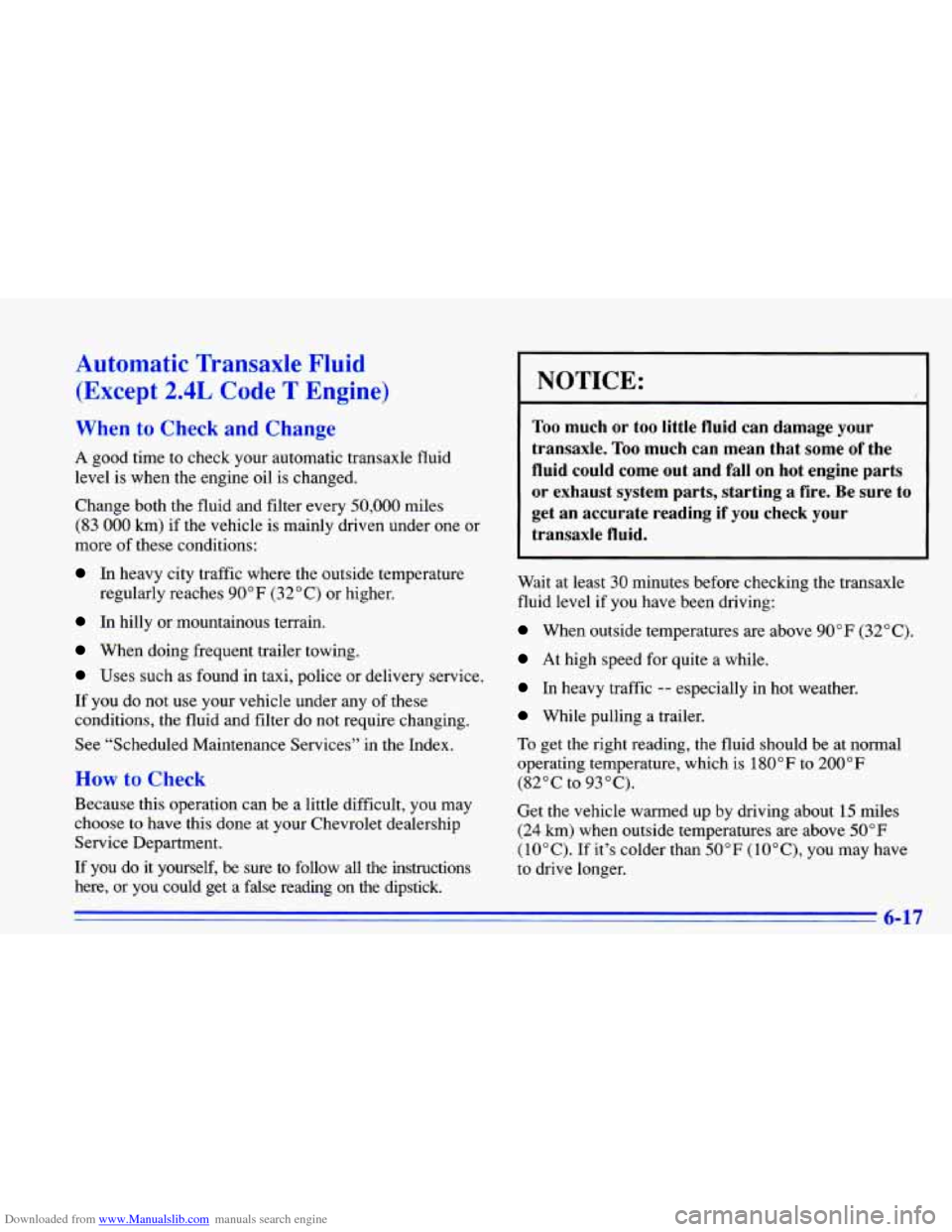
Downloaded from www.Manualslib.com manuals search engine Automatic Transaxle Fluid (Except 2.4L Code
T Engine)
When to Check and ~ anee
A good time to check your automauc transaxle fluid
level is when the engine oil is changed.
Change both the fluid and filter every
50,000 miles
(83
000 km) if the vehicle is mainly driven under one or
more of these conditions:
In heavy city traffic where the outside temperature
regularly reaches
90°F (32°C) or higher.
In hilly or mountainous terrain.
When doing frequent trailer towing.
Uses such as found in taxi, police or delivery service.
If you do not use your vehicle under any of these
conditions, the fluid and filter do not require changing.
See “Scheduled Maintenance Services’’ in the Index.
How to Check
Because this operation can be a little difficult, you may
choose to have this done at your Chevrolet dealership
Service Department.
If you do it yourself, be sure to follow all the instructions
here, or you could get a false reading on the dipstick.
NOTICE:
Too much or too little fluid can damage your
transaxle.
Too much can mean that some of the
fluid could come out and fall on hot engine parts
or exhaust system parts, starting a fire. Be sure to
get
an accurate reading if you check your
transaxle fluid.
Wait at least 30 minutes before checking the transaxle
fluid level if you have been driving:
When outside temperatures are above 90°F (32°C).
At high speed for quite a while.
In heavy traffic -- especially in hot weather.
While pulling a trailer.
To get the right reading, the fluid should be at normal
operating temperature, which is 180”
F to 200” F
(82°C to 93°C).
Get
the vehicle warmed up by driving about 15 miles
(24 km) when outside temperatures are above 50” F
(10°C). If it’s colder than 50°F (lOOC), you may have
to drive longer.
6-17
Page 360 of 372
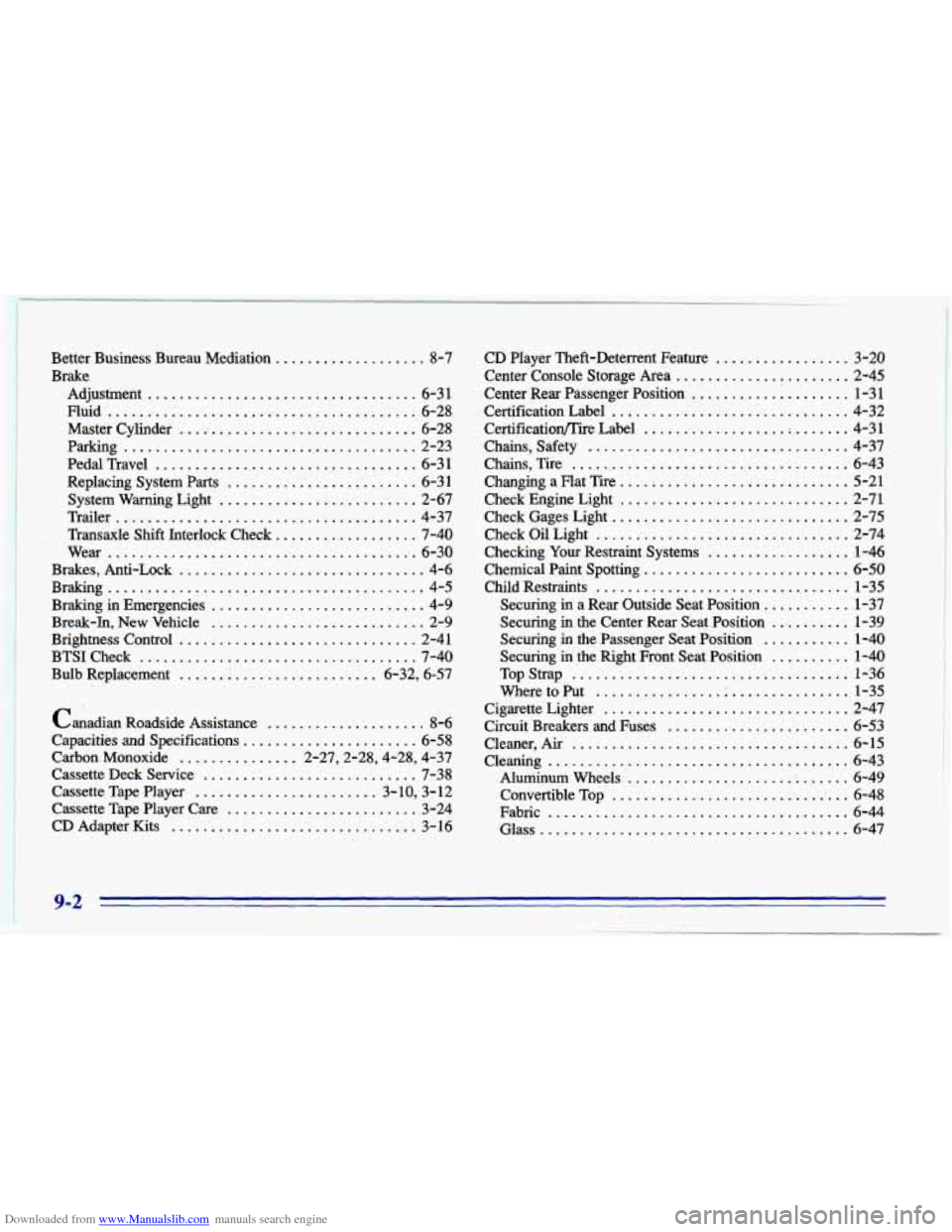
Downloaded from www.Manualslib.com manuals search engine Better Business Bureau Mediation ................... 8-7
Brake Adjustment
.................................. 6-3 1
Master Cylinder ............................... 6-28
Parking
..................................... 2-23
System Warning Light
......................... 2-67
Fluid
....................................... 6-28
Pedal Travel
.................................. 6-3 1
Replacing System Parts ........................ 6-31
Trailer
...................................... 4-37
Transaxle Shift Interlock Check
.................. 7-40
Wear
....................................... 6-30
Brakes. Anti-Lock
............................... 4-6
Braking
........................................ 4-5
Braking in Emergencies
........................... 4-9
Break-In. New Vehicle
........................... 2-9
BTSICheck
................................... 7-40
Bulb Replacement
...... .................. 6-32. 6-57
Brightness Control
.............................. 2-41
Canadian Roadside Assistance
.................... 8-6
Capacities and Specifications
...................... 6-58
Carbon Monoxide
............... 2.27.2.28.4.28. 4.37
Cassette Deck Service
........................... 7-38
Cassette Tape Player ....................... 3.10. 3.12
Cassette Tape Player Care
........................ 3-24
CD Adapter Kits
............................... 3- 16
CD Player Theft-Deterrent Feature ................. 3-20
Center Console Storage Area
...................... 2-45
Center Rear Passenger Position
.................... 1-31
Certification Label
.............................. 4-32
Certificatiooire Label
.................. ; ....... 4-31
Chains. Safety
................................. 4-37
Chains. Tire
................................... 6-43
Changing a Flat Tire
............................. 5-21
Check Engine Light
............................. 2-71
CheckGagesLight
.............................. 2-75
CheckOilLight
................................ 2-74
Checking
Your Restraint Systems .................. 1-46
Chemical Paint Spotting
.......................... 6-50
Child Restraints
................................ 1-35
Securing in a Rear Outside Seat Position
........... 1-37
Securing
in the Center Rear Seat Position .......... 1-39
Securing
in the Passenger Seat Position ........... 1-40
Securing in the Right Front Seat Position
.......... 1-40
TopStrap
................................... 1-36
WheretoPut
................................ 1-35
Cigarette Lighter
............................... 2-47
Circuit Breakers
and Fuses ....................... 6-53
Cleaner. Air ................................... 6-15
Cleaning
...................................... 6-43
Aluminum Wheels
............................ 6-49
Convertible
Top .............................. 6-48
Fabric ...................................... 6-44
Glass
....................................... 6-47
9-2 .
Page 362 of 372
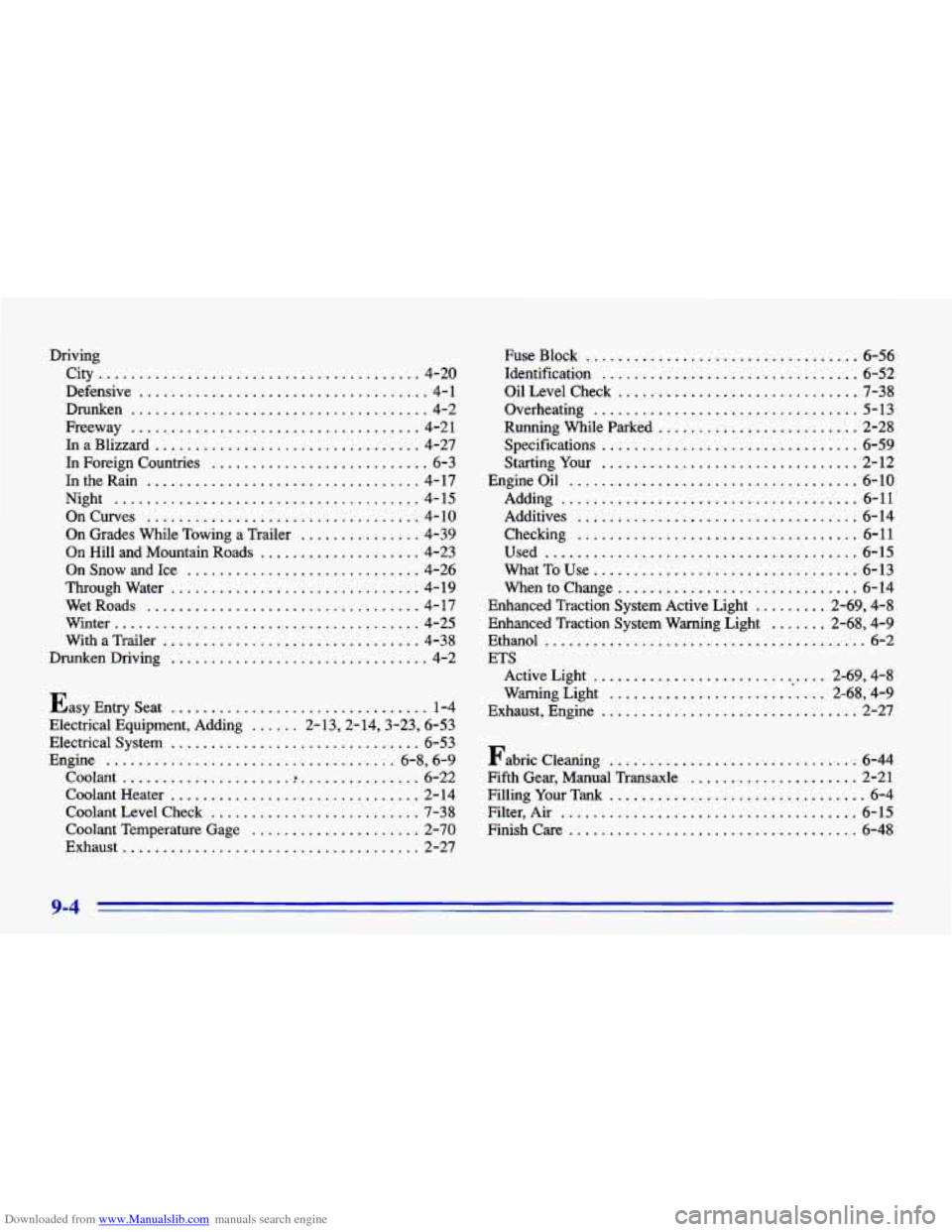
Downloaded from www.Manualslib.com manuals search engine Driving City
........................................ 4-20
Defensive
.................................... 4- 1
Drunken
..................................... 4-2
Freeway
.................................... 4-21
InaBlizzard
................................. 4-27
In Foreign Countries
........................... 6-3
In the Rain .................................. 4-17
Night
...................................... 4-15
OnCurves
.................................. 4-10
On Grades While Towing a Trailer
............... 4-39
On Hill and Mountain Roads
.................... 4-23
On Snow and Ice
............................. 4-26
Throughwater
............................... 4-19
WetRoads
.................................. 4-17
Winter
...................................... 4-25
With a Trailer
................................ 4-38
DrunkenDriving
................................ 4-2
Easy Entry Seat
................................ 1-4
Electrical Equipment. Adding
...... 2.13.2.14.3.23. 6.53
Electrical System
............................... 6-53
Engine
.................................... 6.8. 6.9
Coolant
..................... ! ............... 6-22
Coolant Heater
............................... 2-14
Coolant Level Check
.......................... 7-38
Coolant Temperature Gage ..................... 2-70
Exhaust
..................................... 2-27 Fuse Block
.................................. 6-56
Identification ................................ 6-52
OilLevelCheck
.............................. 7-38
Overheating ................................. 5-13
Running While Parked
......................... 2-28
Specifications
................................ 6-59
Starting Your
................................ 2-12
Engineoil
.................................... 6-10
Adding
..................................... 6-11
Additives ................................... 6-14
Checking
................................... 6-11
Used
............................... .. ....... 6-15
What To Use
................................. 6-13
Whentochange
.............................. 6-14
Enhanced Traction System Active Light
......... 2-69. 4-8
Enhanced Traction System Warning Light
....... 2-68. 4-9
Ethanol
........................................ 6-2
ETS Active Light
............................. 2.69, 4-8
Warning Light
........................... 2.68. 4-9
Exhaust. Engine
................................ 2-27
Fabric Cleaning
............................... 6-44
Fifth Gear. Manual Transaxle
..................... 2-21
FillingYourTank
................................ 6-4
Filter. Air
..................................... 6-15
Finish Care
.................................... 6-48